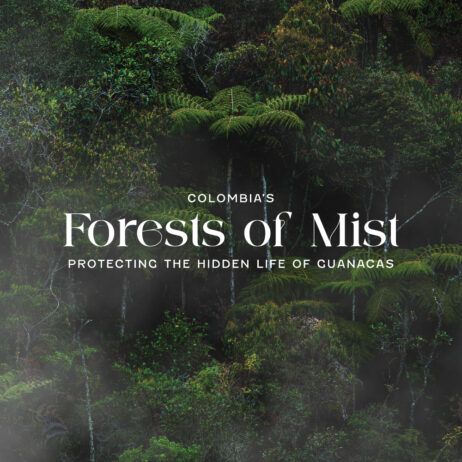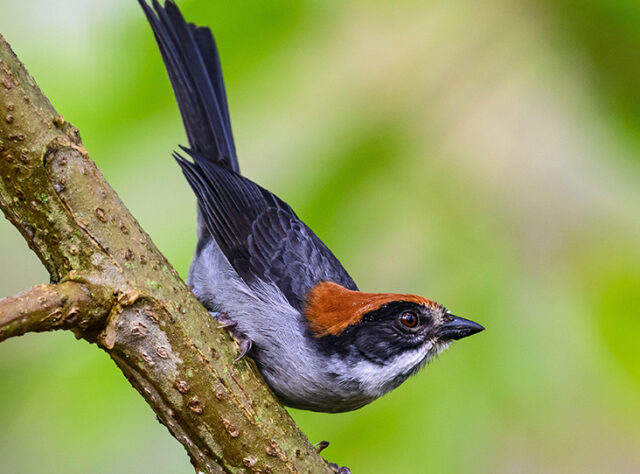
Antioquia Brushfinch (Atlapetes blancae). Credit: Gabbro/Alamy Stock Photo
Colombia is recognised as one of the world’s Megadiverse countries, meaning it is in the world’s top 17 most biodiversity-rich countries. Home to an incredible range of species, habitats, and ecosystems, it has a cultural diversity to match. To take us on a journey through the country where our latest fundraising appeal is located, Richard Cuthbert, Director of Conservation at the World Land Trust, describes a site visit to our Colombian partners. Read on to hear about his sighting of the elusive Critically Endangered Antioquia Brushfinch, a species which will benefit from funds raised in our Colombia’s Forests of Mist appeal.
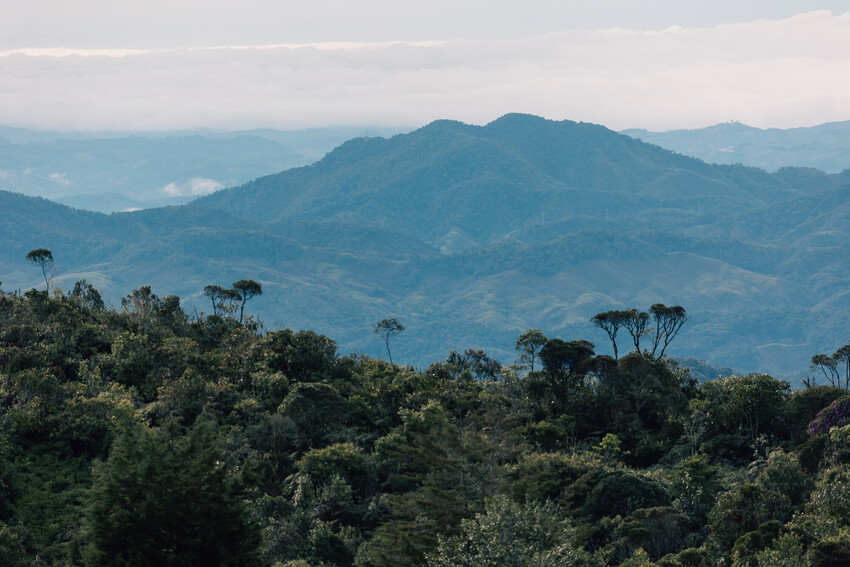
Colombia is as vast in its landscapes as it is diverse in cultures. Credit: Andrea Ferreira.
Bordered by Ecuador, Peru, Brazil, and Venezuela to the south and east, and the Pacific Ocean, Caribbean Sea, and Panama to the north and west, Colombia lies at the meeting point of South and Central America. It thus harbours the biodiversity and cultural diversity of both regions. With landscapes ranging from the glaciated and snow-capped mountains of the northern high Andes to large reaches of the Amazon Basin, along with deserts, mangroves, cold paramos, dry forests and cloud forests, it is nearly impossible to categorise the country other than to highlight the range of different Colombia’s that are present inside it.
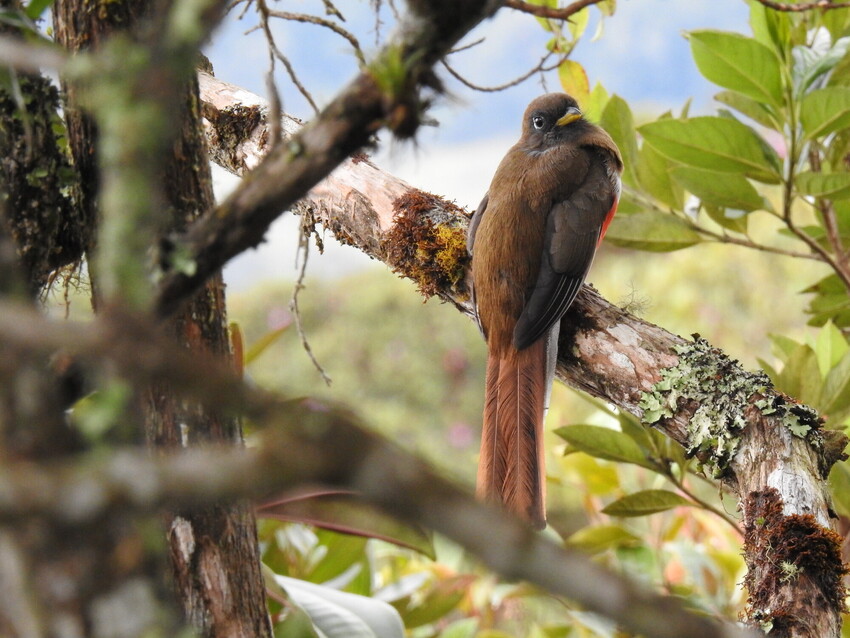
Collared Togron (Togron collaris) in Guanacas Reserve. Credit: Fundación Guanacas/Juan Carlos Macías
Megadiverse countries are of key importance for global biodiversity and Colombia lies only behind Brazil and Indonesia in terms of the total diversity of amphibians, birds, fish, mammals, reptiles, and plants that these countries are known to contain. However, when it comes to birds Colombia tops the list. More species are recorded here than in any other country, with its 1,866 species (as recognised by BirdLife International) comprising almost one fifth of the world’s birds. This includes more than half of the world’s 360 species of hummingbirds.
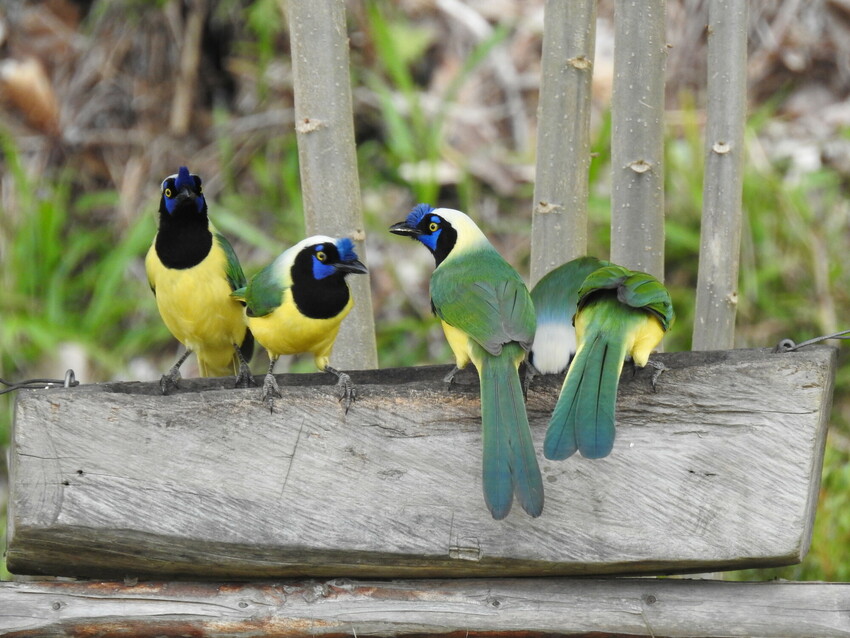
Inca Jays found in Guancas Reserve, Colombia. Credit: Fundación Guanacas/Juan Carlos Macías
Not just bountiful in birds, a recent study by scientists from the Natural History Museum confirms that Colombia has the most butterfly species in the world with its 3,642 butterfly species and 2,085 subspecies comprising 20% of all butterflies found on the planet. Moreover, Colombia’s estimated 26,000 plant species make up 7% of the total plant species known to science in less than 1% of the Earth’s land area.
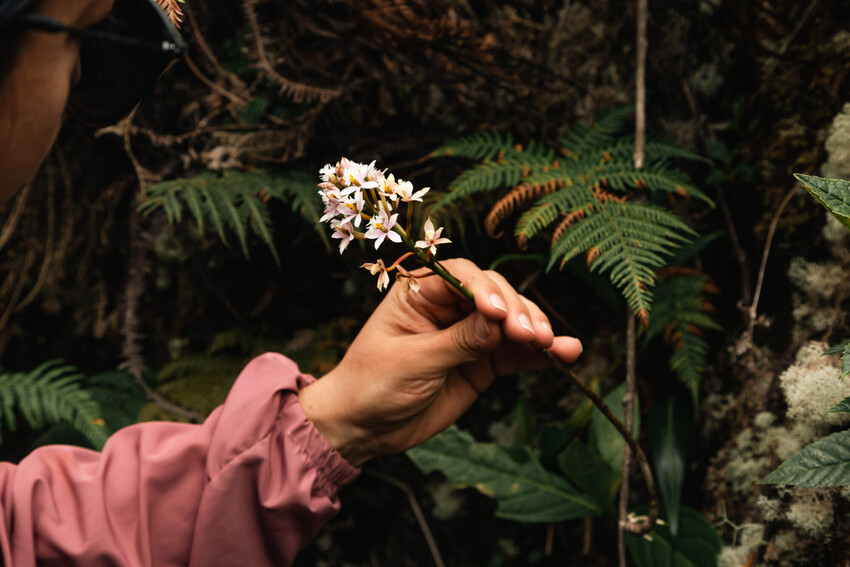
Colombia’s orchid population is one of the richest in the world, with nearly 4,270 species recorded. Credit: Andrea Ferreira.
Visiting Colombia with the World Land Trust
As an ornithologist and conservationist, I had wanted to visit Colombia since the 1990s and see something of the biodiversity of this country, not to mention to sample the coffee and breath in the air and landscapes so brilliantly described in the novels of Gabriel Garcia Marquez. I had previously undertaken research in neighbouring Venezuela and travelled to countries in southern South America. However, Colombia’s long running civil conflict and the time commitments of other conservation roles meant I had to postpone any anticipated visits.
My opportunities to visit changed in 2018 when in a new role as Director of Conservation at the World Land Trust I was finally able to visit Colombia. This trip involved meeting three organisations to see and assess the conservation work they were undertaking to help bring key areas of land into protection.
Despite an over-cramped schedule, the country and my experiences of it were as spectacular as I had always hoped. Some poignant memories included visits to the high elevations of the Tochecito area within Valle del Cauca Province along with a trip to the Middle Magdalena River Valley.
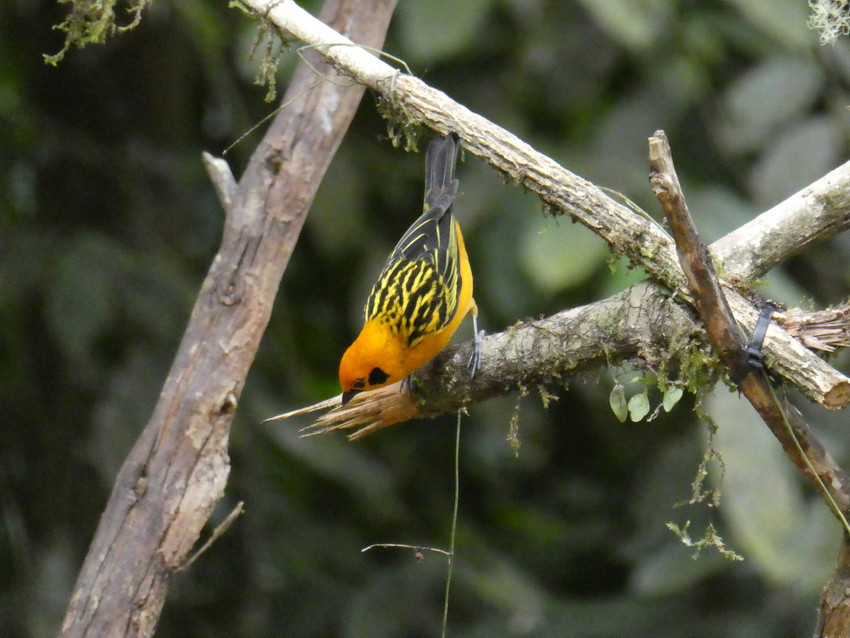
Golden Tanager (angara arthus) in El Silencio Reserve. Credit: Richard Cuthbert/World Land Trust
The former area holds the largest remaining numbers of the Quindío Wax Palm (Ceroxylon quindiuense) Colombia’s national tree and the tallest palm tree in the world reaching heights of up to 60 metres. It towers high above the surrounding pastureland and remaining patches of natural forest. Specimens of this globally threatened species were first collected by scientific polymath Alexander von Humboldt during his journey across Colombia’s Andes in 1801. I was visiting with researchers from the country’s Humboldt Insitute named in his honour and we briefly walked along the same pre-Columbian Quindío Trail that Humboldt would have taken over two hundred years ago.
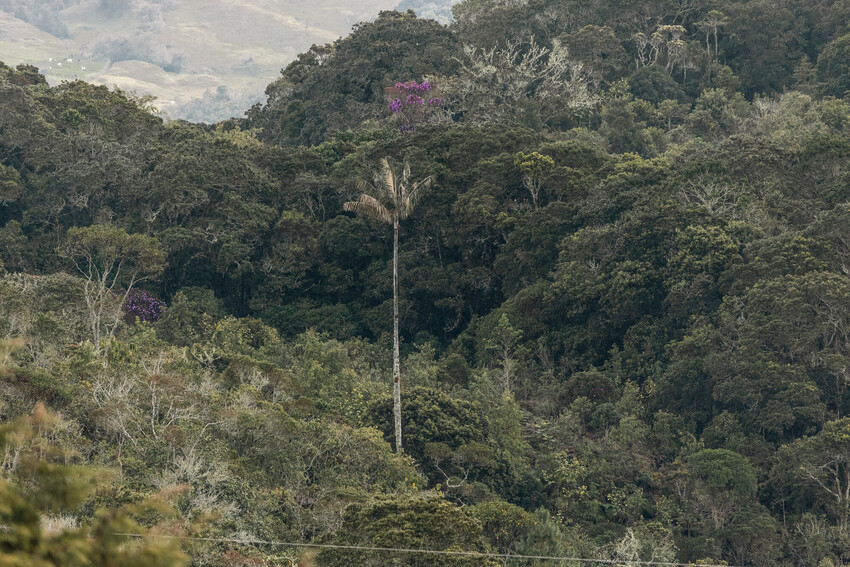
The Quindio Wax Palm is Colombia’s national emblem and is a Vulnerable species. Credit: Andrea Ferreira.
In contrast to the high altitude Tochecito area, the Middle Magdalena River Valley lies in the lowlands between the Cordillera Central and Cordillera Oriental. These represent two of the three ranges of the Andes that spread out like fingers into northern Colombia. My trip here was to accompany the team from a local conservation organisation, Fundacion Biodiversa Colombia, to visit their El Silencio reserve and to assess the opportunity to significantly expand the area of forest under protection. The visit first involved a four-hour journey in a motorized dugout canoe along the Magdalena River. This briefly followed in the footsteps of Garcia Marrquez’s portrait of Simón Bolívar and his final doomed journey along the same river in “The General in His Labyrinth”, before we then walk for two hours to the reserve’s research station.
The El Silencio reserve was as spectacular in its wildlife as it was in its spectacularly erroneous name, for there is nothing silent about this reserve. It echoed with the calls of the Blue-billed Curassow, Northern Screamer, Collared Aracari, Channel-billed Toucan and eleven species of parrots, parrotlets, parakeets and macaws at dawn and dusk. These sounds were followed by the grunting cough of the Jaguar as night fell. Long days in the field, with pre-dawn starts and late nights – all supported by strong black Colombian coffee – provided a memorable visit as well as confirming the need for World Land Trust to support this site.

El Silencio reserve from above. Credit: Fundacion Biodiversa Colombia
In early 2022, following the easing of Covid-related travel restrictions, I visited Colombia for a second time. I went with the aim of looking for further opportunities for the World Land Trust to help support local organisations working to protect areas of land, as well as revisiting the El Silencio reserve to follow up on the expansion of this site. The El Silencio reserve originally measured a small but important 85 hectares in extent. With World Land Trust’s support, this expanded in size to 582 hectares in 2018, before increasing in size again with the support of World Land Trust and other organisations to now encompass nearly 3,400 hectares of rainforests and wetlands of the Middle Magdalena Valley.
Fundacion Biodiversa Colombia’s rangers and researchers are protecting and monitoring the site’s important biodiversity, safeguarding a key area of lowland rainforest, and documenting the reserves biodiversity which includes records for over 230 species of birds and populations of four globally threatened primates. These include the Critically Endangered Brown Spider Monkey, Endangered Varied White-fronted Capuchin and White-footed Tamarin, and Vulnerable Grey-handed Night Monkey.
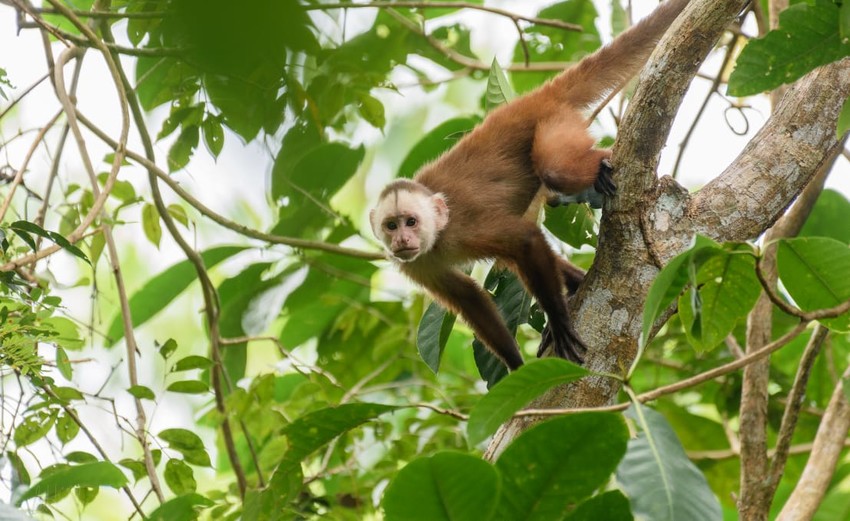
A Varied White-fronted Capuchin (Cebus versicolor) hangs in a tree in one of Fundación Biodiversa Colombia’s project sites. Credit: F Arbelaez
As well as visiting again with Fundacion Biodiversa Colombia, I also saw the work of three other World Land Trust conservation partners. In a hectic itinerary, I spent time with Fundación Projecto Tití and witnessed their programme of work to protect the dry forest habitat of the tiny and charismatic Cotton-top Tamarin monkey. I was also able to see the work of Fundación ProAves at the El Dorado Reserve in La Sierra Nevada de Santa Marta in northern Colombia where 400 bird species, including 21 Sierra Nevada endemics, are recorded in this reserve’s spectacular primary subtropical and montane forests.
The misty refuge of Antioquia
The third organisation I visited was Fundación Guanacas Bosques de Niebla. They have been working for more than 30 years in the ‘forests of mist’ in the mountains of Cerro San Jose in Antioquia region of northwestern Colombia. World Land Trust first supported Fundación Guanacas in 2020 to purchase 130 of land containing important areas of cloud forest but the global pandemic had prevented any visit to the site and partner. This precluded the chance to properly discuss future opportunities for increasing the area of land under protection. A four-hour drive, steadily ascending from the busy city of Medellín, took me through a landscape that had been utterly transformed by agriculture over the last century: bare hillsides of pastureland supporting nothing but cattle and grasses which dominate the terrain, along with old plantations of pine and other non-native trees. Closer to the roads, intensive areas of farming for potatoes, avocados, tree-tomatoes and other fruit and vegetables clung to even the steepest of hillsides. Clearance of natural areas of forest was still ongoing for further crops to support the burgeoning market for fresh produce in Medellín, Colombia’s second city with over 2.5 million inhabitants and a rapidly growing population.

Pasture land to be restored at a WLT partner project site. Credit: Fundación Guanacas
As we drove higher up the hills of the Cerro San Jose, small, isolated patches of natural habitat and forest started to appear, clinging to the tops of hills and steeper slopes. We eventually pulled off the rough road into another unprepossessing patch of pasture on the crest of a hillside. But after a half hour of walking entered another world: in contrast to the modified surrounding landscape, the Guanacas Reserve had managed to retain critical remnant areas of tropical cloud forest which abounded with a striking variety of mosses, ferns, trees and epiphytes. This profusion of plant life generated and guarded the moisture and mist and were the starting points for myriad streams that fed the surrounding region.
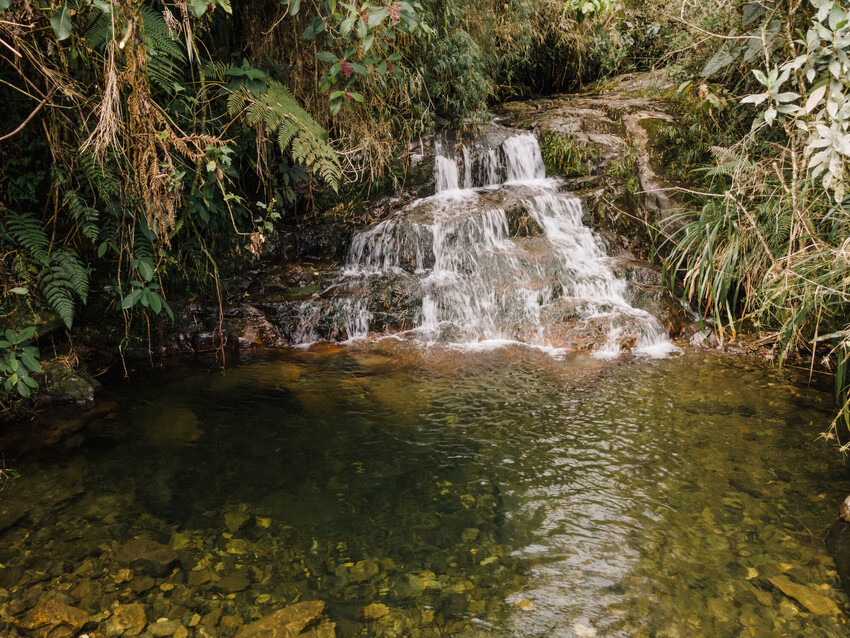
There are over 18 different water currents that flow through Guanacas. Credit: Andrea Ferreira.
The Guanacas expert team pointed out specimens of the Critically Endangered and endemic Magnolia yarumalensis tree and many other threatened trees and shrubs. Where areas of bare pasture remained in the reserve, the Guanacas team were undertaking forest restoration; planting native species from seeds collected within the reserve. This included the Quindío Wax Palm that I had seen previously in Tochecito. Along with its plant diversity, the reserve holds three of the six cat species that are found in Colombia (the Puma, Ocelot and Oncilla), and key populations of threatened amphibians including the gloriously named Buckley’s Giant Glassfrog and the Chocolate Frog that would not have been out of place in a Harry Potter book.
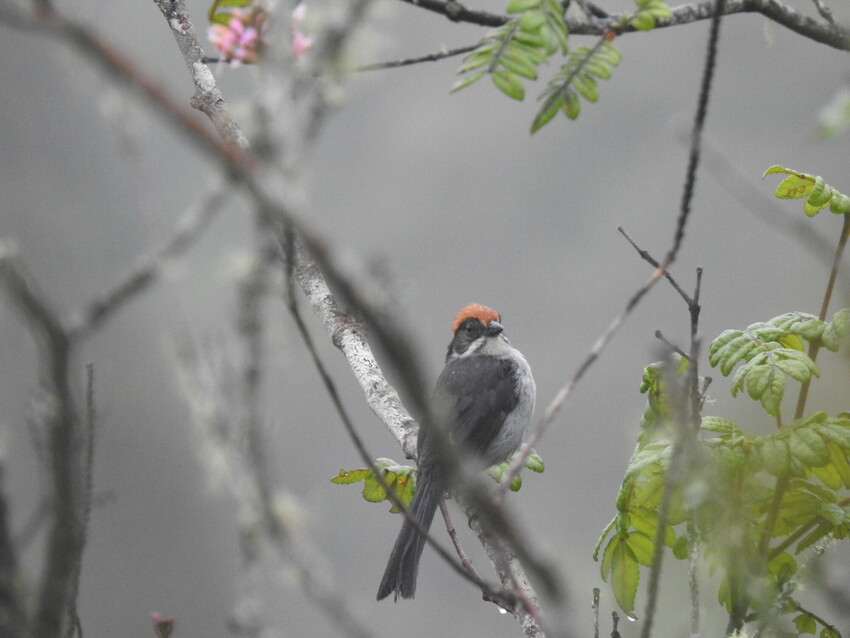
Antioquia Brushfinch perched on a branch in Guanacas. Credit: Juan Carlos Macías.
The jewel in the crown: the Antioquia Brush-finch
In 1971, three rather drab looking brush-finches were collected by researchers from Bogotá’s Universidad de la Salle who were visiting near San Pedro de los Milagros in the Antioquia region. These specimens, which were labelled as Slaty Brush-finches, lay undisturbed for more than 30 years. This was until British ornithologist Thomas Donovan, who was working with ProAves in Colombia, came across them during his research on other species of brush-finches and realised that he was handling an undescribed species.
The Antioquia Brush-finch (Atlapetes blancae) was formally described as a species in 2007, but subsequent searches in the locality of where the original birds had been collected failed to find any living examples of this species. More than another decade passed until 2018 when Correa Peña, an engineering student at a local university who had been learning to identify birds, recognised what he thought was an Antioquia Brush-finch close to the locality where the type specimens had been collected. Visits from other expert Colombian ornithologists confirmed that the Antioquia Brush-finch had indeed been rediscovered in the wild.

Fewer than 100 individual Antioquia Brush-finches are estimated to exist today across 25 locales including Guanacas Reserve. Credit: Fundación Guanacas/Juan Carlos Macías
Subsequent visits by Colombian ornithologists and teams from the American Bird Conservancy surveyed areas around San Pedro de los Milagros and the surrounding region. They focused their efforts on the small, scattered areas of remaining natural forest and scrub habitat that the species had been found in. The species has now been found in 25 locales in the region, though still a tiny population of fewer than 100 birds are believed to remain. Amongst the locations that these teams surveyed, the Antioquia Brush-finch was observed in the border areas of the Guanacas Reserve. In 2021, the American Bird Conservancy and World Land Trust collaborated to help the Guanacas team to purchase three parcels of land and expand the reserve to incorporate these key areas for this special Brush-finch.

A fog hands above the forest canopy at Guanacas Reserve. Credit: Andrea Ferreira.
Ongoing efforts to conserve and restore land within Antioquia
WLT’s Autumn appeal, Colombia’s Forests of Mists aims to expand protecions for the incredible Antioquia Brush-finch, as well as to restore its scrubland habitat. This can only happen with the generousity of WLT supporters. With your help, Fundación Guanacas will expand the Guanacas Reserve area which will also secure a future for 14 other threatened species that seek sanctuary in this precious landscape. Support our Colombia’s Forests of Mist appeal and donate today.
